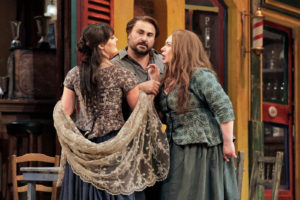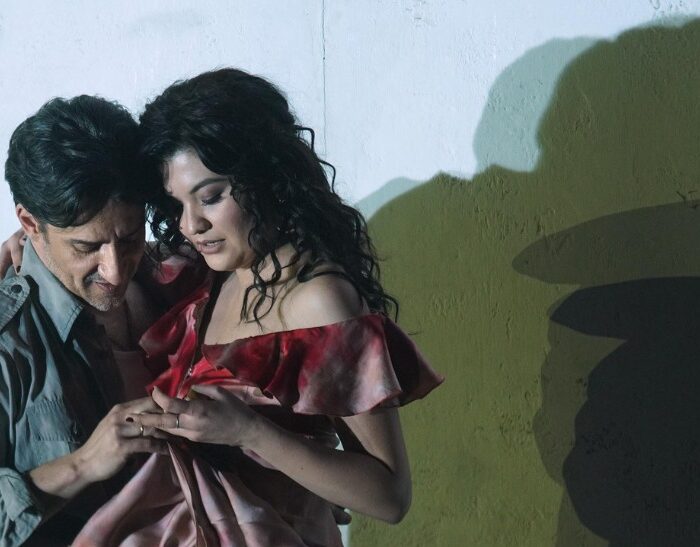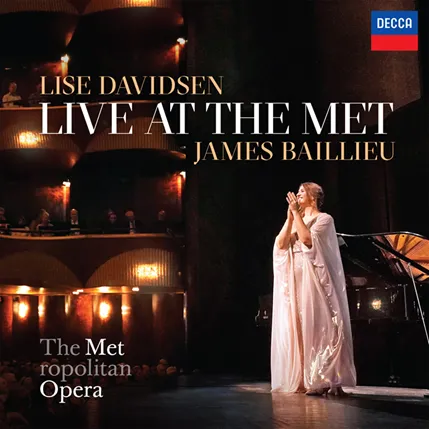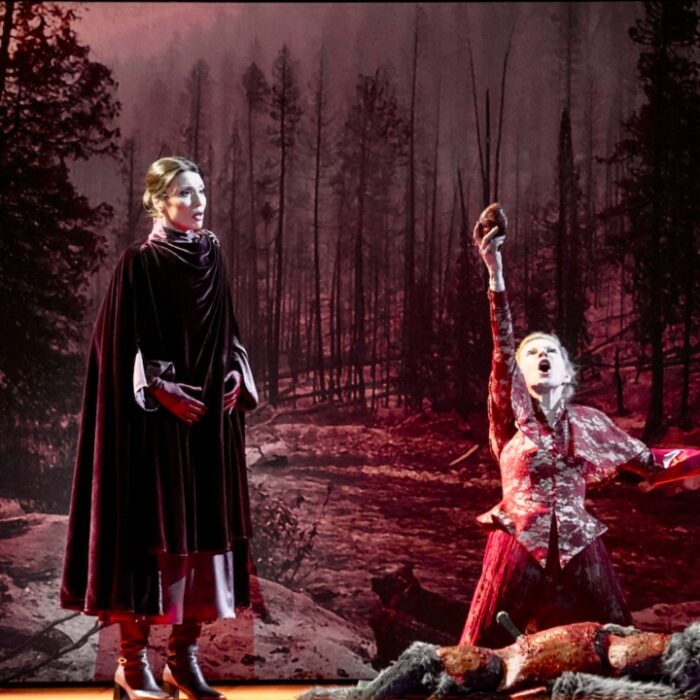
San Francisco Opera 2018-19 Review: Cavalleria Rusticana & Pagliacci
Great Singing From Ekaterina Semenchuk, Dimitri Platanias Steal The Show
By Lois SilversteinSan Francisco Opera’s double bill of “Cavalleria Rusticana” and “Pagliacci” is fully set in the same neighborhood of La Boca in Buenos Aires, Argentina. It opens with women shaking bedding from the windows, waiters straightening up the chairs from last night’s wine, lovers snatching their last kiss. The characters then emerged from it and sang the story; at the end, they sank back into their worlds, one of them declared, “La commedia est finita.” Directed by Jose Cura, along with revival director, Jose Maria Condemi, it even included “Mascagni” and “Leoncavallo” on stage. Once again, here was Opera crossing boundaries. Did it work?
Blurring Lines
Yes and No. To blur distinctions of reality in the theater is not new. The Prologue to “Pagliacci” is a “commedia del arte” convention and appears in many other arenas; the Chorus commenting on what occurs derives from Greek theater; Pirandello played on these too after the operas were produced. Today’s reality shows make it an almost daily occurrence. The mingling of “real” and “imagined,” “here” and “there,” aimed to strengthen the impact of the two operas: to depict life in “verismo” panels emphasized that what occurred here was more than in just one time and one place; rather it was wide and more comprehensive. Lust, betrayal, murder are human and timeless and borderless. The gauntlet was thrown: we are who we are.
With regard to the world of the operas themselves, characters, stories and music, little was affected. The operas impel because of intense emotion and some exceptional music.However attractive and well-articulated the background, it served as jumping off-point for the heart of the matter; so what was the gain from such sociological perspective? How did it deepen the actual performance? When Santuzza, from “Cavalleria” joined the audience in “Pagliacci,” six months pregnant, what more do we know of her anguish? When Mama Lucia stepped out of her role at the Finale to point us to the real world into which we then return, how did our view grow?
The “Cav” Cast
Mezzo-soprano Ekaterina Semenchuk sang a warm and earthy Santuzza. An outcast in her community, it was Santuzza’s anguish we felt throughout, largely because of the naked honesty she conveyed as woman wounded, jealous and abandoned. When she pleaded with Mama Lucia, “Io son dannata/ Andate, o mamma, ad implorare Iddio, e pregate per me,” it was the fullness of voice and emotional power that conveyed love and devotion. She herself had our sympathy, not necessarily the woman from the Italian quarter of a strong community. Even when she revealed Lola and Turiddu’s treachery, we stood by her, her intense passion calling forth our own feeling.
Turiddu, sung by tenor Roberto Aronica, was aptly harsh. From the outset, Aronica moved and sang with a keen, sharp-edged deceit, the line between honesty and deception, especially thin after we were forewarned by Santuzza’s view. We did not need to look far for his lies. “Bada, Santuzza, schiavo non sono/di questa vana tua gelosia!” was sung with robustness and penetrating highs. When Santuzza replied, “Battimi, insultami, t’amo e perdono, ma è troppo forte l’angoscia mia,” we felt him feel her grief. Forever they were locked in their tearing love-hate embrace. Aronica’s farewell to Mama Lucia was poignant, exploring some of Turridu’s other side. However, it lacked some authenticity.
Lola, interpreted by soprano Laura Krumm with seductive charm in voice and movement, provided a good partner to Aronica, as did Mama Lucia, sung by Jill Grove, the conventional dichotomy between “mother and whore,” taking the stage.
Alfio, Lola’s husband, sung by baritone Dimitri Platanias in his SFO debut, appeared earnest, forthright, and deliberate. His hail-fellow-well-met appearance at the outset, effectively disguised the degree to which his rage might go. Buoyant and friendly, he sang with strong resonance and confidence. Before he hit his high notes, however, he seemed to thrust his voice as if to make sure he hit them with accuracy, and although he did, every time, this lacked appeal as well as smooth sonority.
The “Pag” Team
When Plantanias appeared as Tonio in “Pagliacci,” he sang with some of the same result, but his cogent and compact presentation had more positive impact. He sang with vigor and pathos and appealed as he pushed us away. We took pity on him even as he clawed at Nedda, who subsequently whipped him. He wrapped himself in the stage-within-a-stage curtain, his poignant aria, while not as compelling as it might have been, was moving and resonant. It was hard to forget it, or let it go.
Soprano Lianna Haroutounian sang Nedda with moving vitality and her voice soared at times with exceptional beauty. Moreover, her facial flexibility and deft movement complemented her lyricism; even her whipping of Tonio convinced.
Tenor Marco Berti sang Canio with ardor. In the first act, it was Canio that said “Il teatro e la vita non son la stessa cosa,” making sure what we ask ourselves – both the actual and drama’s audience – not to confuse the two. Did we actually need his mask to cover another a mask side by side with a play within a play? And a frame around both? The eyelashes on his “actual” cheek did, however, suggest more of a human aspect and did strengthen that aspect of the layered story. As far as “Vesti la Giubba,” Berti sang with plaintive appeal. Will we ever get over such a series of notes? Doubtful.
Beppe, the carrot-haired clown, sung by Amitai Pati , current Adler Fellow at SFO, performed the role with charm and ease. Silvio, sung by David Pershall, convinced as Lola’s lover.
So too the Chorus, directed by Ian Robertson, which fulfilled its community portrait as well. Here, however, the abundance of the crowd on stage caused diffusion, the busy-ness distracting from the centrality of the ensemble’s role. To introduce not only a juggler, with more than one juggling routine, a magician with more than a single magic act, seemed gratuitous. How much reality did we need, in each act? While a tip of the hat to the staging of Act two of “Bohème,” we noted in Puccini the central characters conveyed detail plus central plot information. In both this double bill, an abundance of detail thinned out some of the power they tried to depict. It seemed somewhat as if background moved into the foreground without plot, emotion, or musical “raison d’être” altered. Even the famous Intermezzo, became more like an accompaniment. Easter morning it was, the community in church, and perhaps time for meditation and reflection, particularly after all that has transpired. Instead, dance occurs. However artful and passionately the dancers Alexandra FitzGibbon and Jekyns Pelaez, performed, and they did, it felt unnecessary to have them fill that timely and essential space. So too , several of the gags in “Pagliacci” included the fastidious folding of the costumes, denuding the wagon of so many costumes, sitting and moving and standing and sitting again. We could picture a stage nearly bare, a flag or curtain, a stool, maybe perhaps a geranium in a flower pot to carry the heart of the story. We didn’t require an actual circus to portray one.
The orchestra for both operas, under SFO debutant Maestro Daniele Callegari, brought the often-sumptuous music to the fore; never did it falter, whether it be the exquisite harp, the low-drums, or the sweep of violins. At times, however, some allegro tempi dominated when we might have had more solemnity. One such example is when Santuzza sang beside the lamp post, allowing us to better experience the weight of her grief, her loneliness, and loss. Also, Turiddu’s plea to Alfio did not wring the music to the sentimental, even as we rode its crest; never did we cross over. The sets and production the costumes, by Fernand Ruiz, also in his SFO debut, supervised Jai Alltizer, aptly established the world, with rich color.
This was ultimately a fine performance with lots to enjoy, even if conceptually the production did seem like it might be trying a bit to hard to put forth its ideas instead of letting the works themselves do the heavy lifting, which they are more than capable of doing.


